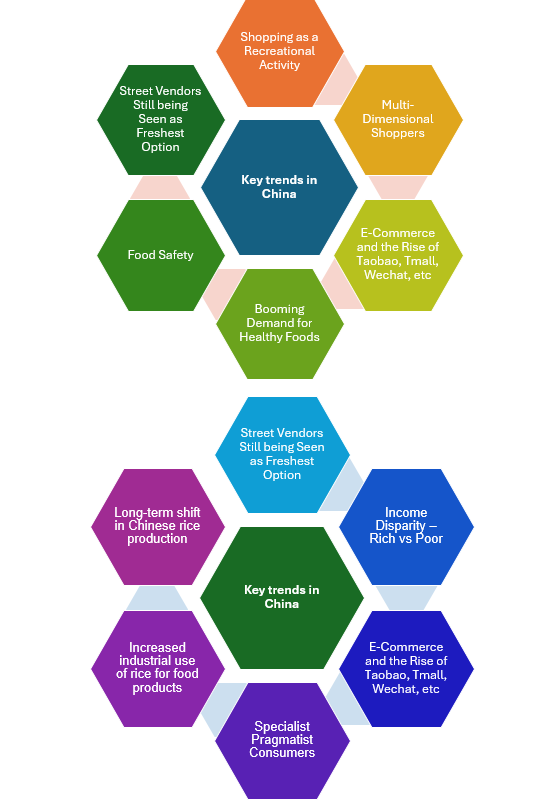World markets are an inconsequential sideshow for China’s rice industry
The main spectacle is the battle for domestic market domination now taking place between national champion COFCO and Asian agribusiness behemoth Wilmar.
- 30 mn ha of rice and a production of 140.5 MMT of milled rice
- Rice area is projected to contract by 1.6 mn ha.
- Total rice consumption is growing at 0.37% per year, all of which is due to population growth as per capita rice consumption declines marginally.
- Once largely neglected by the giants of the country’s food industry, in the last few years rice milling has come to be viewed by them as a key driver of medium- and long-term growth.
- The two largest agribusiness companies in China - China Oil and Food Corporation (COFCO) and Wilmar International (east. 2007) - have engaged in an intensifying race to invest in bigger and more efficient mills in key rice-producing areas

- At the same time, they are pouring equal amounts of financial resources into building rice brands with nationwide distribution among the largest retail supermarkets chains.
- Though a newcomer that has built its own production from scratch, Wilmar has leveraged its huge edible oils distribution network.
- Midea, China’s largest rice-cooker maker buys some 200 MT of rice a year to fuel its product research.
Brands tend to still be local, but it is possible to find some brands are emerging nationally.
In some cases, a single brand will use rice from various localities, but will clearly mark on the package where the rice is from.
- Chinese consumers will look at the origin of rice in their rice purchasing decision.
- There is considerable choice that is emerging for consumers.
Large chains (domestic or foreign) have gradually shifted to sourcing direct from large milling companies, such as COFCO and Wilmar as well as a few other large mills and several specialized rice wholesale companies. This vertical coordination of large retailers with large mills is a significant transformation.
Emerging vertical coordination between large mills and large wholesalers in wholesale markets (and outside of wholesale markets).
- Urban wholesale market traders’ source by far the most from medium and large mills, and little from small mills.
- Large mills use a system of large traders as exclusive or near exclusive agents, but informal relationships.
Aiding the vertical coordination is the emergence of packaging and branding rice, especially by medium and large mills. This presumably increases the competitiveness of the large mills, which can defend a brand.
Urban consumers are also becoming more multi-dimensional shoppers because of growing income levels and concerns for food safety.
- They are becoming more interested in aesthetic appeal, innovative design, and implied status of products, as well as how specific products target their own personal needs
Industry Structure
China’s rice industry comprises a large number of geographically diverse farms and mills.
The industry historically consisted of small-scale, labor-intensive enterprises.
Slowly shifting towards larger, more capital-intensive enterprises in response to rising costs and pressures on resources, such as labor, land, and water.
- Corporations with large-scale mills and national distribution of their brands may now account for 20% to 25% of the rice milled in China. There maybe around 25 such companies.
- Village mills doing just five or 10 TPD have mostly disappeared in the last five years. The remaining mills, numbering in the tens of thousands, fall within a capacity range of 50 to 200 TPD.
- Both Wilmar and COFCO have invested heavily in mills in the northeast, because it is a rice surplus area. The Japonica rice variety grown there is reputed for its flavor and is gaining favor and distribution throughout China.
- State-owned, diversified agribusiness concern Beidahuang Group has a rice milling capacity of 3 MMT.
- Jinjian Rice Company based in Hunan Province has the most extended geographic coverage, operating mills in Heilongjiang in the far north, Hainan in the far south, and inland in Sichuan Province. Products include rice bran oil and instant rice flour.
- About 20 smaller companies with national aspirations make up a second tier in the corporate milling sector.
Modernization of the Chinese rice industry, driven in large part by food security concerns, has been facilitated by government policies on price supports, input subsidies, the development of hybrid varieties, and infrastructure development.
- As a result, the productivity of the Chinese rice industry has increased and is higher than that of other major Asian rice producers.
China has a range of climatic zones that enable diverse rice production areas, multicropping, and multiple harvests, offering the country and year round supply
Most Chinese rice production is in the Yangtze River valley and areas to the south, where water is relatively abundant.
The share of total rice production accounted for by northern China doubled between 1995 and 2009, reaching 15 percent in the latter year.

Changing consumption trends
Northern Chinese consumed wheat-based foods and southern Chinese ate rice
- In the burgeoning cities, diets are increasingly varied.
Supermarkets in northern cities now have more offerings of attractively packaged rice.
Urban consumers are demanding higher quality rice and paying a premium for it.
- Thus, branding strategies have become critical in rice marketing. There are many hundreds of rice brands sold in China. At least 40 of them have been certified as a “famous China brand”
Wilmar and COFCO have applied their blanket Jinlongyu and Fulinmen brands respectively to their broad range of packaged foods and oils.
Many northeners have acquired a taste for rice and that is supporting consumption.





